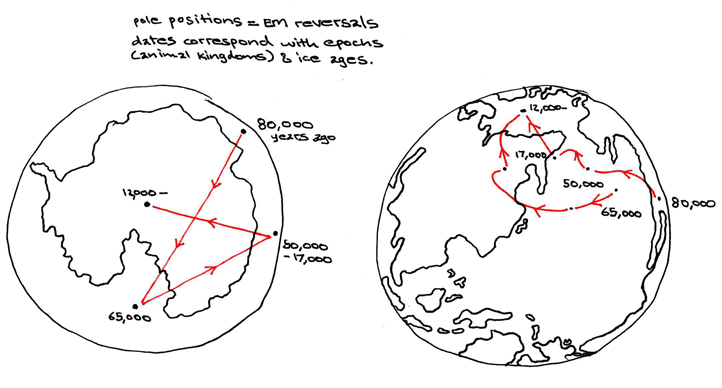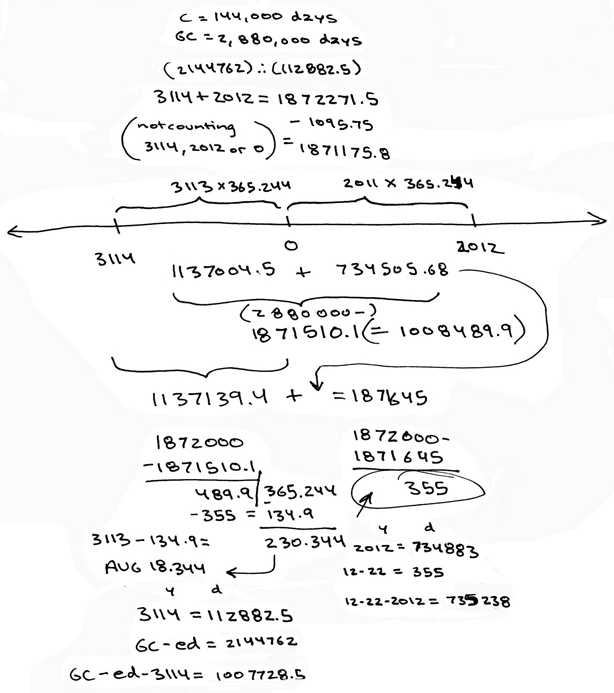
Calendars
-----------------------------------------------------
-----------------------------------------------------
-----------------------------------------------------
-----------------------------------------------------
I will now draw some allusions between the ice ages, sunspots and the Mayan calendar. Alot of this information is complex, but it all fascinates me. If you are interested in any of this please be patient as I try to explain it all simply. Otherwise, pardon my dust.
----------------------------------------------------------------------------------------------------------------
ICE AGES
Precession
As we are all taught in school, the polar axis of earth's rotation isn't perfectly square to its orbital path around the sun.
The axis of rotation is inclined 23.5 degrees.
Also, the earth's orbit isn't perfectly circular. It is more ovoid - elliptical. The sun is not at the dead center of the earth's orbit either. It is closer to the base of the egg shaped ellipse rather than the tip.
Now we all know it is these two factors that combine to cause earth's seasons. When the northern hemisphere faces the sun it is summer. When the northern hemisphere faces away from the sun it is winter. This is true even if, as is currently the case, the northern hemisphere faces the sun when the earth is further away from the sun in its elliptical orbit (closer to the "tip" of the "egg".)
What we are not taught in school is the precession of the pole. As the earth rotates around the 23.5 degree angle inclined polar axis, so too does this polar axis rotate. It rotates, or precesses, so slowly, though, that it takes about 24,000 years to come full circle.

Calendars
Just as we measure the seasons of the year by the months of the calendar, so also can we measure the seasons of the aeons by the millennia.
While months derive from the phases of the moon (of which there are 13 every 384 days), the standard julian-gregorian calendar derives from the moon's position relative to the twelve signs of the zodiac. This yields 365 days, more proximal to an actual orbit of earth around the sun, and one month per sign.
So, to measure precession, we can also use the zodiac, but instead of the moon we use the sun. Just as the moon orbits one way through the zodiac, the sun moves the opposite way - not from day to day (both rise in the east and set in the west due to earth's daily rotation), but over the millennia, the sun will rise in earlier and earlier constellations on the same day of the year.
Thus, the spring equinox occured in Aries a little more than 2000 years ago. Today it occurs on the cusp of Picses and Aquarius. Hence, we are entering the "age of Aquarius" due to how we measure precession.
Ice Ages
Just as yearly seasons depend on both the earth's tilted angle of rotation and elliptical orbit, so too do the ice ages, or precessional seasons.
When the northern hemisphere faces the sun and earth is close to the sun (the opposite of now) it is millennial summer in the north, and winter (or an ice age) in the south. During the last time this happened, the glaciers that had covered North America and Europe melted, covering the Beringian land bridge between Asia and Alaska. Most of this extra water froze in the southern hemsiphere.
Now, the northern hemisphere faces the sun when earth is further away from the sun. We are in approximately northern hemsiphere autumn. Siberia has become frozen and inhospitable. The southern hemisphere, however, is in the equivalent of millennial spring, with huge ice chunks the size of Rhode Island breaking off the Antarctic ice shelf. As Antarctica is thawing, Siberia is freezing. We are entering a north hemisphere ice age.
But not to worry. This part of the cycle has only been going on for 4,000 to 10,000 years, and the ice age cycle lasts, per hemisphere, about 48,000 years.
recap
So we have seen it takes about 2,000 years for the zodiacal "ages"; of the sun to change from one sign to another, and that this is because it takes about 24,000 years for the precession of the poles to reposition earth relative to the sun for it to have risen on the same day in each of the twelve zodiacal signs. We have also seen that it takes roughly twice this long for the combination of polar precession and earth's elliptical orbit to effect the millennial equivalent of the seasons, known as ice ages.
Sunspots
Now, what we may or may not learn in school is that the earth really has two polar axes: a geographic pole and an electromagnetic pole.
The sun also has an electromagnetic pole. As the sun's electromagnetic pole rotates about its polar axis, the sun's electromagnetic field coils up around it, like a ball of twine. This is because the sun is ignited gas, and its surface rotates differentially: the region around the equator rotates more slowly than the region around the poles. This causes the ordinarily longitudinal electromagnetic field lines of the sun to be pulled around its latitude, and thus to form "coils" like a "twine ball"
The longer this process goes on, the closer these emf lines get to each other. When they touch or overlap they form colder, dark spots on the surface of the sun. These "sunspots" always occur in pairs. Sometimes they shoot protons - burning gas particles - off into space. These are called flares. Most of the time, one sunspot shoots a flare out and another sunspot re-absorbs it. These are called prominences.
Sunspot Cycle
Every eleven years sunspots increase. The reason for this is not fully understood, but I suspect the soalr weather is caused by a combination of electromagnetic polar precession (i.e. differential rotation) and the sun's place in its orbit around the center of the Milky Way galaxy.
Mini Ice Ages
When sunspot number is low, he hemisphere of earth facing the sun will not be as warm as it usually is in that same position in its elliptical orbit. When this occurs there is a "mini ice age" when all seasons are uncommonly colder. Such occured in Europe around 400 AD.
By dating these mini ice ages, we can create a much longer sunspot cycle than merely the eleven year cycle of increase. Doing so yields a greater sunspot cycle of ~ 1000 years, over which time the sunspots increase per increment of eleven years.
----------------------------------------------------------------------------------------------------------------
the MAYAN CALENDAR
The Mayan calendar is probably the most advanced calendar created on earth since the beginning of recorded history.
I won't bother to explain it in detail, but it is based on very exact astronomical observations we are only just now begining to understand, and measures much greater amounts of time than the people who used it were actually around for.
The end of one great cycle (in 2012) has now been found to correspond with the end of a sunspot cycle (of eleven years, and possibly one of 1000 years). This has fed much eschatology, but it need not necessarily herald the end of the material world so much as a spiritual rebirth into a new age, or zodiacal aeon.

According to my calculations, the duration between the Mayan calendar start date given as Aug. 13, 3114 bce and the "end" date of Dec. 21, 2012 ce...
= 1872000 kin
= 93600 unial
= 5200 tun
= 260 katun
= 1 tonalamatl
= 13 baktun
Discuss this section on the forums
-----------------------------------------------------
-----------------------------------------------------
-----------------------------------------------------
-----------------------------------------------------
this information is all © 2004- Jonathan Barlow Gee
LINKS: